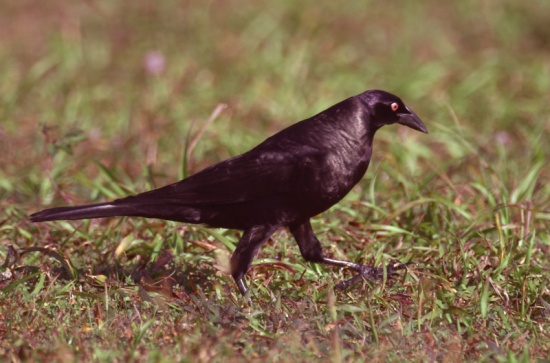(habitat, behav, remove {{incomplete}}) |
(id) |
||
| Line 3: | Line 3: | ||
''Scaphidura oryzivora'' | ''Scaphidura oryzivora'' | ||
==Identification== | ==Identification== | ||
| + | Male and female similar except that female is smaller. Overall the species is black with some feather shine, it has a conspicuous ruff around the neck giving it a smallheaded/bull-necked appearance and it has a large black bill. <br /> | ||
Iris is reddish in [[Mexico]] and most of [[Central America]] becoming more yellow as one goes east in [[Panama]]. | Iris is reddish in [[Mexico]] and most of [[Central America]] becoming more yellow as one goes east in [[Panama]]. | ||
==Distribution== | ==Distribution== | ||
Revision as of 00:32, 7 January 2013
- Molothrus oryzivorus
Scaphidura oryzivora
Identification
Male and female similar except that female is smaller. Overall the species is black with some feather shine, it has a conspicuous ruff around the neck giving it a smallheaded/bull-necked appearance and it has a large black bill.
Iris is reddish in Mexico and most of Central America becoming more yellow as one goes east in Panama.
Distribution
From Mexico in Southern North America through Central America and South America to Argentina and Bolivia
Taxonomy
Subspecies[1]
- M. o. impacifus:
- M. o. oryzivorus:
Habitat
Semiopen to open areas like forest clearings, wooded savannahs, fields, etc, but usually near colonies of nest hosts.
Behaviour
Feeds mainly on the ground but also observed feeding on larger mammals (eating biting flies and similar) and occasionally by gleaning from leaves
Nest predator which mainly deposit eggs in Oropendolas and Caciques, but also described as predating a couple of Jay species and a couple of large orioles.
References
- Clements, JF. 2008. The Clements Checklist of Birds of the World. 6th ed., with updates to December 2008. Ithaca: Cornell Univ. Press. ISBN 978-0801445019.
- Neotropical birds online
Recommended Citation
- BirdForum Opus contributors. (2024) Giant Cowbird. In: BirdForum, the forum for wild birds and birding. Retrieved 20 May 2024 from https://www.birdforum.net/opus/Giant_Cowbird




